The Treaty on European Union (Maastricht Treaty) Explained
VerifiedAdded on 2019/12/03
|13
|4060
|168
Report
AI Summary
This report provides a comprehensive analysis of the Treaty on European Union (Maastricht Treaty) of 1991, detailing its historical and political context and impact on the European Union. The report begins with an introduction to the EU, defining it as an economic and political partnership among its member states, and outlining the role of treaties in its development. It then explores the Maastricht Treaty itself, explaining its key elements, objectives, and the concept of European citizenship. The report further examines the historical and political development of the EU, highlighting the evolution from the post-World War II era to the signing of the Maastricht Treaty. It also discusses Article 1 of the TEU, which outlines the common provisions and principles of the EU and its constitutional structure, including the three-pillar structure. The report concludes by emphasizing the enhancement of European integration facilitated by the EU and the distinct issues addressed within European law.
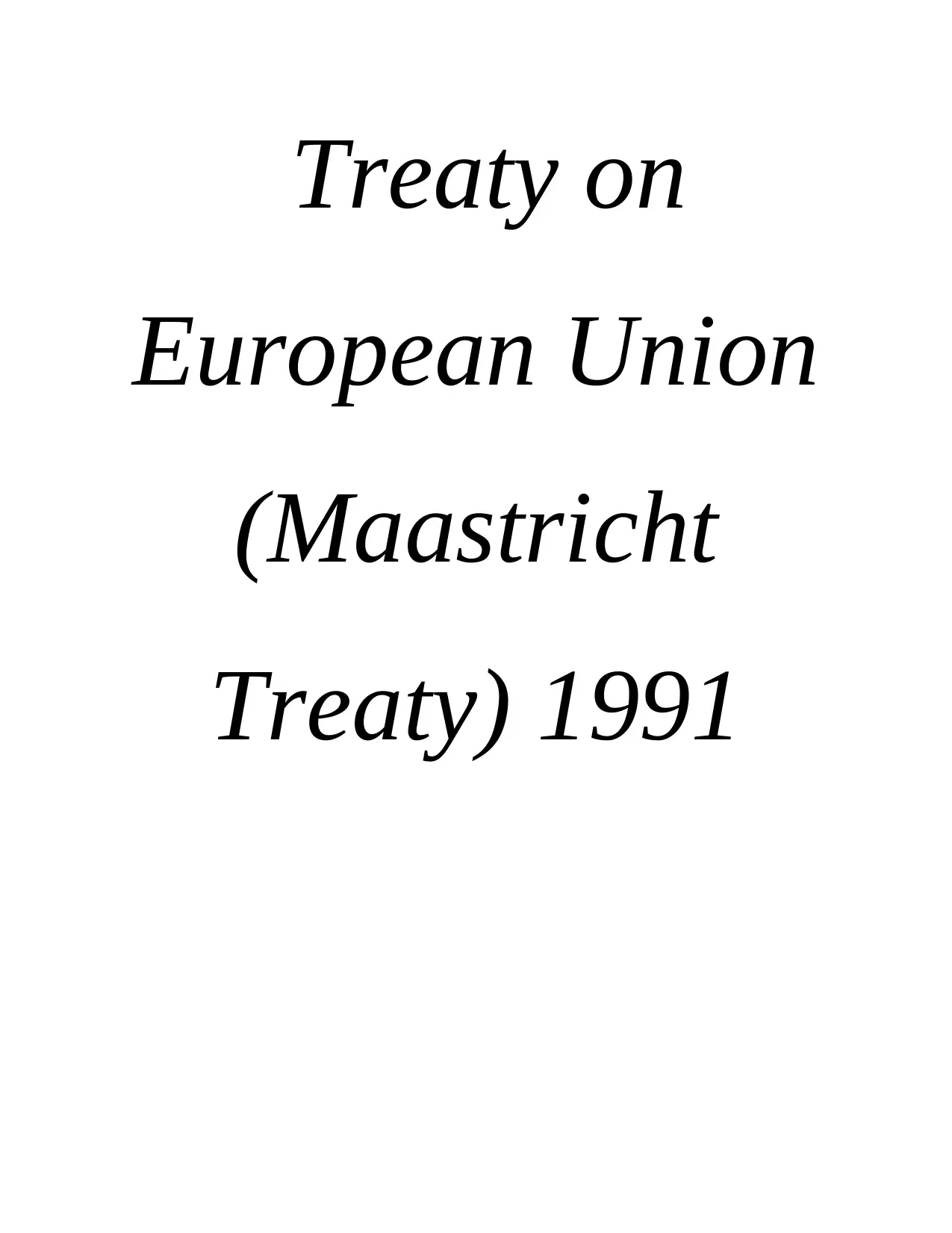
Treaty on
European Union
(Maastricht
Treaty) 1991
European Union
(Maastricht
Treaty) 1991
Paraphrase This Document
Need a fresh take? Get an instant paraphrase of this document with our AI Paraphraser
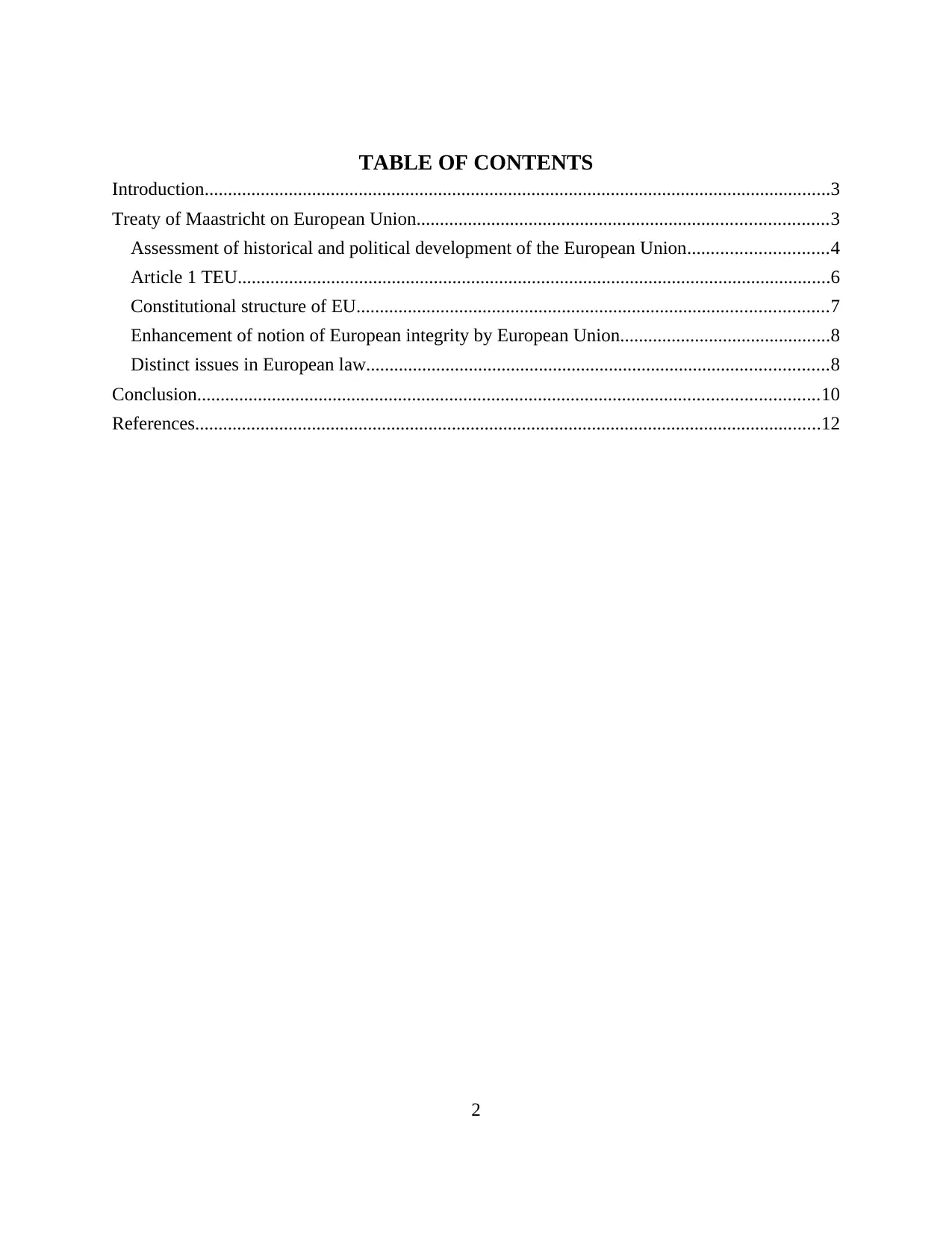
TABLE OF CONTENTS
Introduction......................................................................................................................................3
Treaty of Maastricht on European Union........................................................................................3
Assessment of historical and political development of the European Union..............................4
Article 1 TEU...............................................................................................................................6
Constitutional structure of EU.....................................................................................................7
Enhancement of notion of European integrity by European Union.............................................8
Distinct issues in European law...................................................................................................8
Conclusion.....................................................................................................................................10
References......................................................................................................................................12
2
Introduction......................................................................................................................................3
Treaty of Maastricht on European Union........................................................................................3
Assessment of historical and political development of the European Union..............................4
Article 1 TEU...............................................................................................................................6
Constitutional structure of EU.....................................................................................................7
Enhancement of notion of European integrity by European Union.............................................8
Distinct issues in European law...................................................................................................8
Conclusion.....................................................................................................................................10
References......................................................................................................................................12
2

ILLUSTRATION INDEX
Illustration 1: Pillars of European Union.........................................................................................8
3
Illustration 1: Pillars of European Union.........................................................................................8
3
⊘ This is a preview!⊘
Do you want full access?
Subscribe today to unlock all pages.

Trusted by 1+ million students worldwide
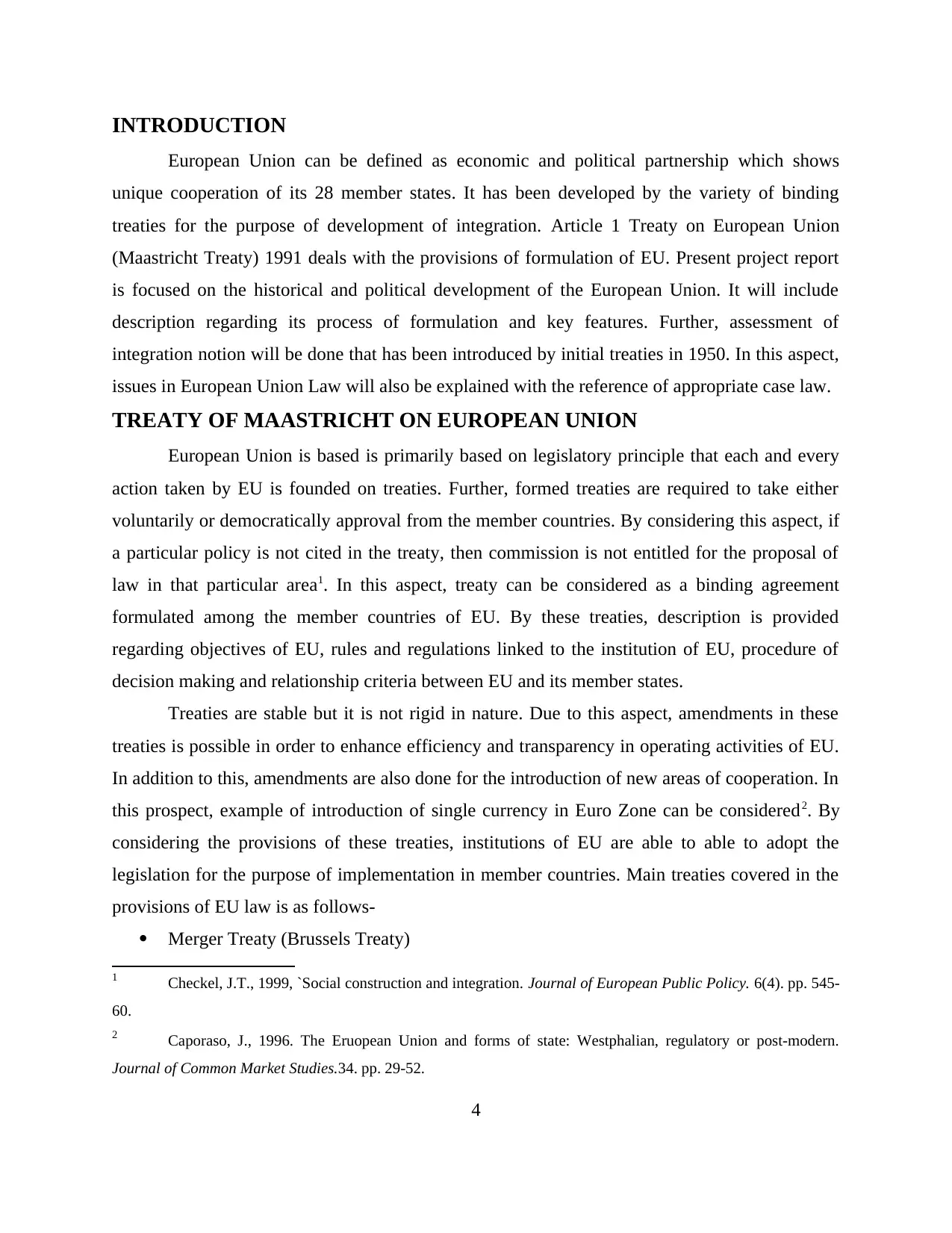
INTRODUCTION
European Union can be defined as economic and political partnership which shows
unique cooperation of its 28 member states. It has been developed by the variety of binding
treaties for the purpose of development of integration. Article 1 Treaty on European Union
(Maastricht Treaty) 1991 deals with the provisions of formulation of EU. Present project report
is focused on the historical and political development of the European Union. It will include
description regarding its process of formulation and key features. Further, assessment of
integration notion will be done that has been introduced by initial treaties in 1950. In this aspect,
issues in European Union Law will also be explained with the reference of appropriate case law.
TREATY OF MAASTRICHT ON EUROPEAN UNION
European Union is based is primarily based on legislatory principle that each and every
action taken by EU is founded on treaties. Further, formed treaties are required to take either
voluntarily or democratically approval from the member countries. By considering this aspect, if
a particular policy is not cited in the treaty, then commission is not entitled for the proposal of
law in that particular area1. In this aspect, treaty can be considered as a binding agreement
formulated among the member countries of EU. By these treaties, description is provided
regarding objectives of EU, rules and regulations linked to the institution of EU, procedure of
decision making and relationship criteria between EU and its member states.
Treaties are stable but it is not rigid in nature. Due to this aspect, amendments in these
treaties is possible in order to enhance efficiency and transparency in operating activities of EU.
In addition to this, amendments are also done for the introduction of new areas of cooperation. In
this prospect, example of introduction of single currency in Euro Zone can be considered2. By
considering the provisions of these treaties, institutions of EU are able to able to adopt the
legislation for the purpose of implementation in member countries. Main treaties covered in the
provisions of EU law is as follows-
Merger Treaty (Brussels Treaty)
1 Checkel, J.T., 1999, `Social construction and integration. Journal of European Public Policy. 6(4). pp. 545-
60.
2 Caporaso, J., 1996. The Eruopean Union and forms of state: Westphalian, regulatory or post-modern.
Journal of Common Market Studies.34. pp. 29-52.
4
European Union can be defined as economic and political partnership which shows
unique cooperation of its 28 member states. It has been developed by the variety of binding
treaties for the purpose of development of integration. Article 1 Treaty on European Union
(Maastricht Treaty) 1991 deals with the provisions of formulation of EU. Present project report
is focused on the historical and political development of the European Union. It will include
description regarding its process of formulation and key features. Further, assessment of
integration notion will be done that has been introduced by initial treaties in 1950. In this aspect,
issues in European Union Law will also be explained with the reference of appropriate case law.
TREATY OF MAASTRICHT ON EUROPEAN UNION
European Union is based is primarily based on legislatory principle that each and every
action taken by EU is founded on treaties. Further, formed treaties are required to take either
voluntarily or democratically approval from the member countries. By considering this aspect, if
a particular policy is not cited in the treaty, then commission is not entitled for the proposal of
law in that particular area1. In this aspect, treaty can be considered as a binding agreement
formulated among the member countries of EU. By these treaties, description is provided
regarding objectives of EU, rules and regulations linked to the institution of EU, procedure of
decision making and relationship criteria between EU and its member states.
Treaties are stable but it is not rigid in nature. Due to this aspect, amendments in these
treaties is possible in order to enhance efficiency and transparency in operating activities of EU.
In addition to this, amendments are also done for the introduction of new areas of cooperation. In
this prospect, example of introduction of single currency in Euro Zone can be considered2. By
considering the provisions of these treaties, institutions of EU are able to able to adopt the
legislation for the purpose of implementation in member countries. Main treaties covered in the
provisions of EU law is as follows-
Merger Treaty (Brussels Treaty)
1 Checkel, J.T., 1999, `Social construction and integration. Journal of European Public Policy. 6(4). pp. 545-
60.
2 Caporaso, J., 1996. The Eruopean Union and forms of state: Westphalian, regulatory or post-modern.
Journal of Common Market Studies.34. pp. 29-52.
4
Paraphrase This Document
Need a fresh take? Get an instant paraphrase of this document with our AI Paraphraser
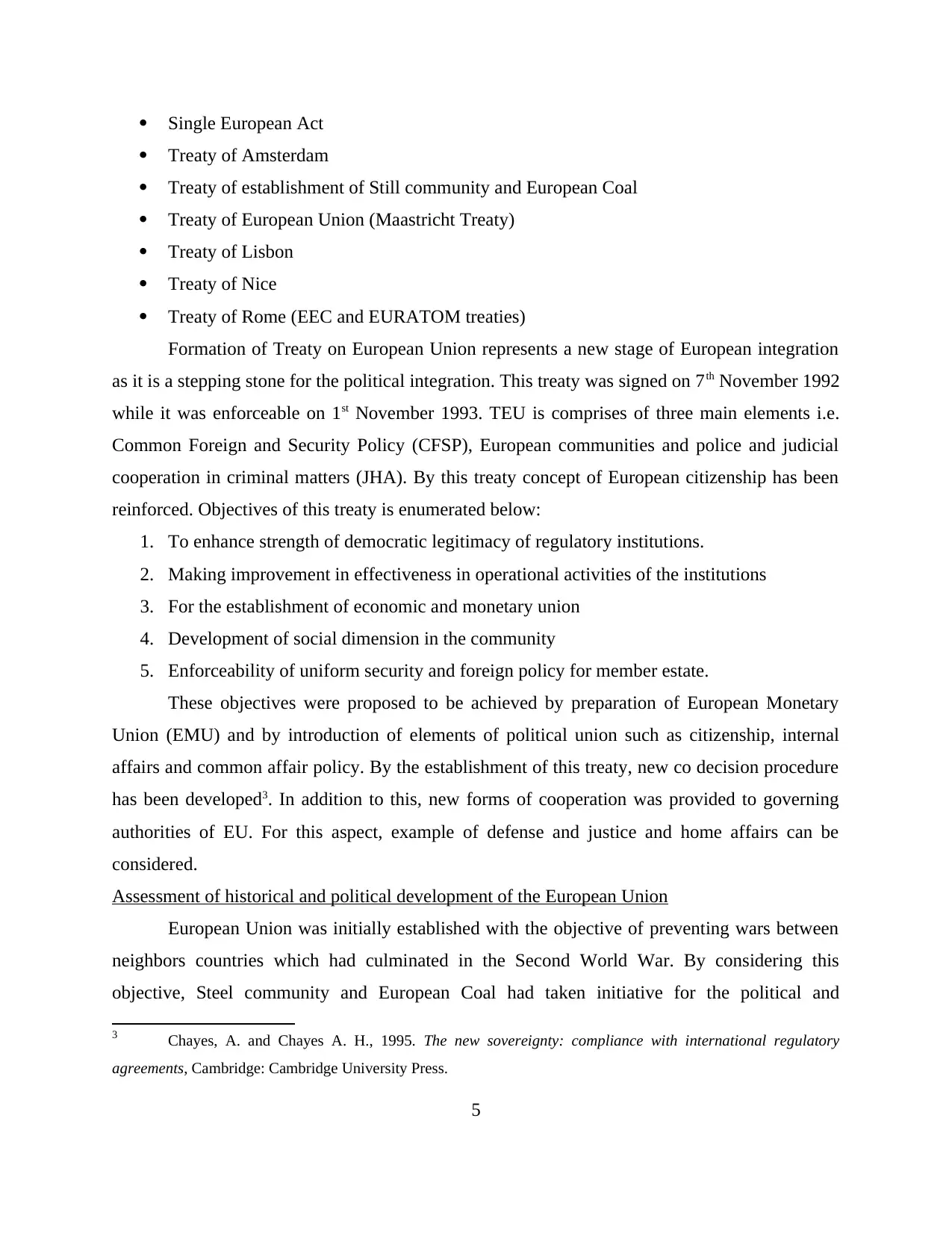
Single European Act
Treaty of Amsterdam
Treaty of establishment of Still community and European Coal
Treaty of European Union (Maastricht Treaty)
Treaty of Lisbon
Treaty of Nice
Treaty of Rome (EEC and EURATOM treaties)
Formation of Treaty on European Union represents a new stage of European integration
as it is a stepping stone for the political integration. This treaty was signed on 7th November 1992
while it was enforceable on 1st November 1993. TEU is comprises of three main elements i.e.
Common Foreign and Security Policy (CFSP), European communities and police and judicial
cooperation in criminal matters (JHA). By this treaty concept of European citizenship has been
reinforced. Objectives of this treaty is enumerated below:
1. To enhance strength of democratic legitimacy of regulatory institutions.
2. Making improvement in effectiveness in operational activities of the institutions
3. For the establishment of economic and monetary union
4. Development of social dimension in the community
5. Enforceability of uniform security and foreign policy for member estate.
These objectives were proposed to be achieved by preparation of European Monetary
Union (EMU) and by introduction of elements of political union such as citizenship, internal
affairs and common affair policy. By the establishment of this treaty, new co decision procedure
has been developed3. In addition to this, new forms of cooperation was provided to governing
authorities of EU. For this aspect, example of defense and justice and home affairs can be
considered.
Assessment of historical and political development of the European Union
European Union was initially established with the objective of preventing wars between
neighbors countries which had culminated in the Second World War. By considering this
objective, Steel community and European Coal had taken initiative for the political and
3 Chayes, A. and Chayes A. H., 1995. The new sovereignty: compliance with international regulatory
agreements, Cambridge: Cambridge University Press.
5
Treaty of Amsterdam
Treaty of establishment of Still community and European Coal
Treaty of European Union (Maastricht Treaty)
Treaty of Lisbon
Treaty of Nice
Treaty of Rome (EEC and EURATOM treaties)
Formation of Treaty on European Union represents a new stage of European integration
as it is a stepping stone for the political integration. This treaty was signed on 7th November 1992
while it was enforceable on 1st November 1993. TEU is comprises of three main elements i.e.
Common Foreign and Security Policy (CFSP), European communities and police and judicial
cooperation in criminal matters (JHA). By this treaty concept of European citizenship has been
reinforced. Objectives of this treaty is enumerated below:
1. To enhance strength of democratic legitimacy of regulatory institutions.
2. Making improvement in effectiveness in operational activities of the institutions
3. For the establishment of economic and monetary union
4. Development of social dimension in the community
5. Enforceability of uniform security and foreign policy for member estate.
These objectives were proposed to be achieved by preparation of European Monetary
Union (EMU) and by introduction of elements of political union such as citizenship, internal
affairs and common affair policy. By the establishment of this treaty, new co decision procedure
has been developed3. In addition to this, new forms of cooperation was provided to governing
authorities of EU. For this aspect, example of defense and justice and home affairs can be
considered.
Assessment of historical and political development of the European Union
European Union was initially established with the objective of preventing wars between
neighbors countries which had culminated in the Second World War. By considering this
objective, Steel community and European Coal had taken initiative for the political and
3 Chayes, A. and Chayes A. H., 1995. The new sovereignty: compliance with international regulatory
agreements, Cambridge: Cambridge University Press.
5
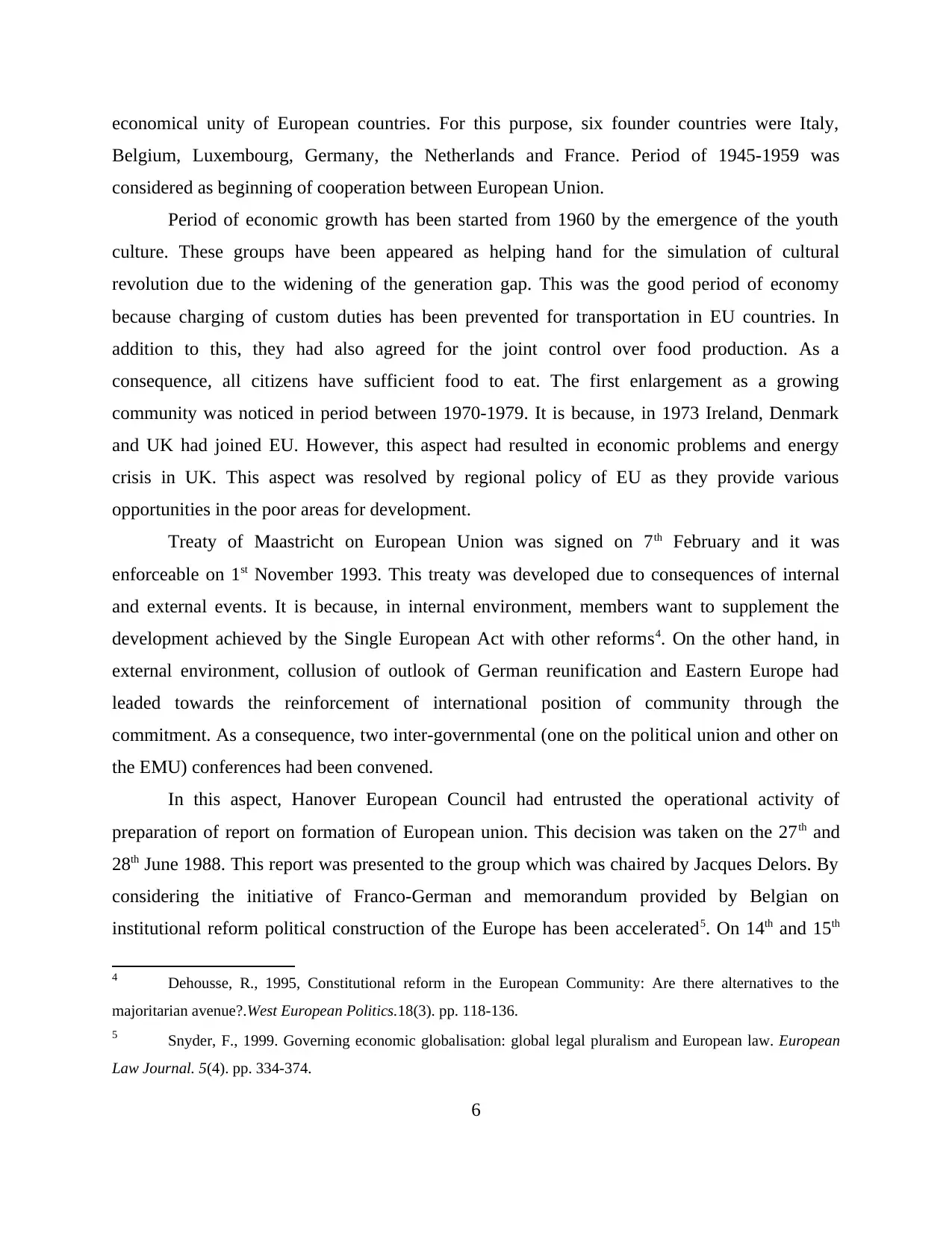
economical unity of European countries. For this purpose, six founder countries were Italy,
Belgium, Luxembourg, Germany, the Netherlands and France. Period of 1945-1959 was
considered as beginning of cooperation between European Union.
Period of economic growth has been started from 1960 by the emergence of the youth
culture. These groups have been appeared as helping hand for the simulation of cultural
revolution due to the widening of the generation gap. This was the good period of economy
because charging of custom duties has been prevented for transportation in EU countries. In
addition to this, they had also agreed for the joint control over food production. As a
consequence, all citizens have sufficient food to eat. The first enlargement as a growing
community was noticed in period between 1970-1979. It is because, in 1973 Ireland, Denmark
and UK had joined EU. However, this aspect had resulted in economic problems and energy
crisis in UK. This aspect was resolved by regional policy of EU as they provide various
opportunities in the poor areas for development.
Treaty of Maastricht on European Union was signed on 7th February and it was
enforceable on 1st November 1993. This treaty was developed due to consequences of internal
and external events. It is because, in internal environment, members want to supplement the
development achieved by the Single European Act with other reforms4. On the other hand, in
external environment, collusion of outlook of German reunification and Eastern Europe had
leaded towards the reinforcement of international position of community through the
commitment. As a consequence, two inter-governmental (one on the political union and other on
the EMU) conferences had been convened.
In this aspect, Hanover European Council had entrusted the operational activity of
preparation of report on formation of European union. This decision was taken on the 27th and
28th June 1988. This report was presented to the group which was chaired by Jacques Delors. By
considering the initiative of Franco-German and memorandum provided by Belgian on
institutional reform political construction of the Europe has been accelerated5. On 14th and 15th
4 Dehousse, R., 1995, Constitutional reform in the European Community: Are there alternatives to the
majoritarian avenue?.West European Politics.18(3). pp. 118-136.
5 Snyder, F., 1999. Governing economic globalisation: global legal pluralism and European law. European
Law Journal. 5(4). pp. 334-374.
6
Belgium, Luxembourg, Germany, the Netherlands and France. Period of 1945-1959 was
considered as beginning of cooperation between European Union.
Period of economic growth has been started from 1960 by the emergence of the youth
culture. These groups have been appeared as helping hand for the simulation of cultural
revolution due to the widening of the generation gap. This was the good period of economy
because charging of custom duties has been prevented for transportation in EU countries. In
addition to this, they had also agreed for the joint control over food production. As a
consequence, all citizens have sufficient food to eat. The first enlargement as a growing
community was noticed in period between 1970-1979. It is because, in 1973 Ireland, Denmark
and UK had joined EU. However, this aspect had resulted in economic problems and energy
crisis in UK. This aspect was resolved by regional policy of EU as they provide various
opportunities in the poor areas for development.
Treaty of Maastricht on European Union was signed on 7th February and it was
enforceable on 1st November 1993. This treaty was developed due to consequences of internal
and external events. It is because, in internal environment, members want to supplement the
development achieved by the Single European Act with other reforms4. On the other hand, in
external environment, collusion of outlook of German reunification and Eastern Europe had
leaded towards the reinforcement of international position of community through the
commitment. As a consequence, two inter-governmental (one on the political union and other on
the EMU) conferences had been convened.
In this aspect, Hanover European Council had entrusted the operational activity of
preparation of report on formation of European union. This decision was taken on the 27th and
28th June 1988. This report was presented to the group which was chaired by Jacques Delors. By
considering the initiative of Franco-German and memorandum provided by Belgian on
institutional reform political construction of the Europe has been accelerated5. On 14th and 15th
4 Dehousse, R., 1995, Constitutional reform in the European Community: Are there alternatives to the
majoritarian avenue?.West European Politics.18(3). pp. 118-136.
5 Snyder, F., 1999. Governing economic globalisation: global legal pluralism and European law. European
Law Journal. 5(4). pp. 334-374.
6
⊘ This is a preview!⊘
Do you want full access?
Subscribe today to unlock all pages.

Trusted by 1+ million students worldwide
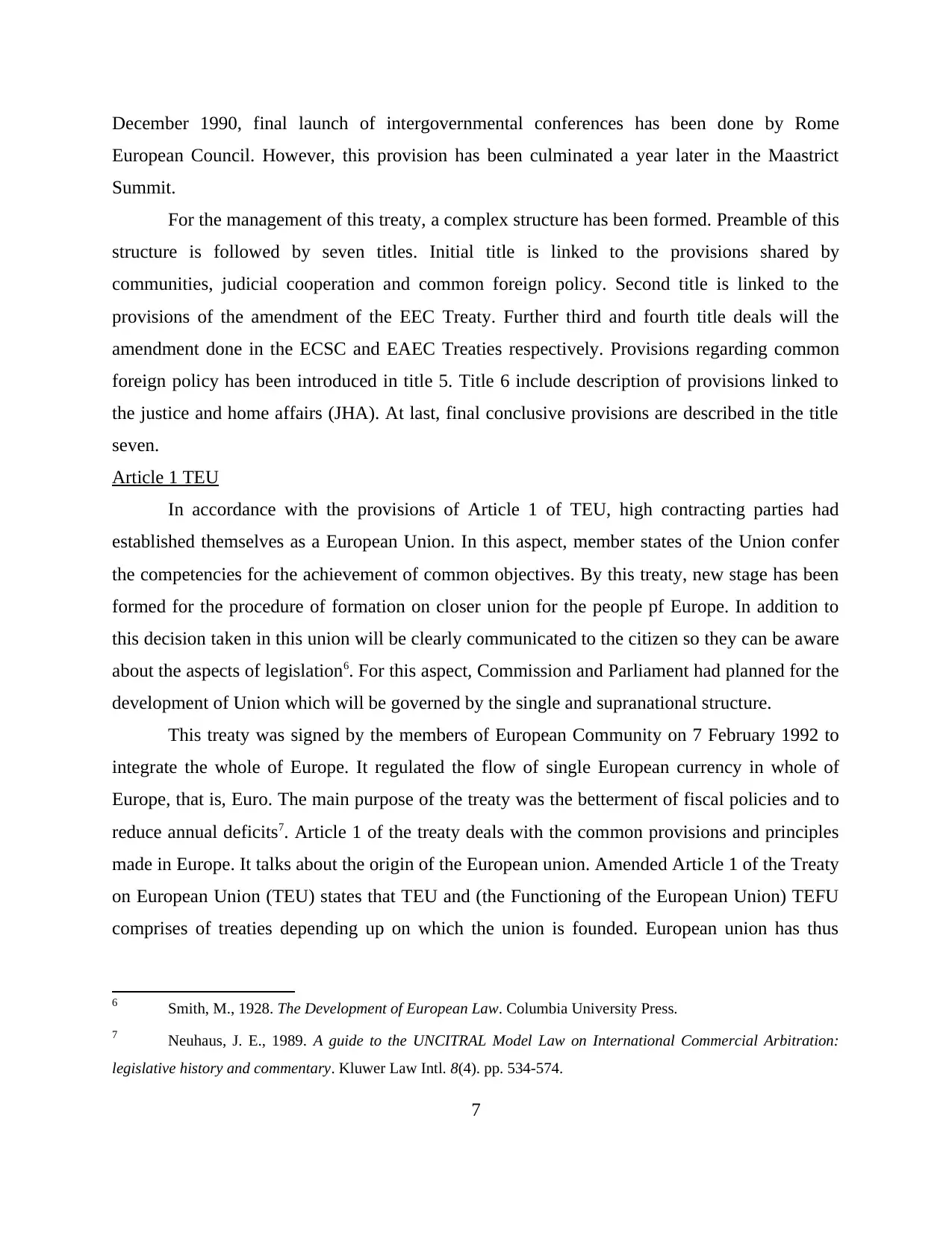
December 1990, final launch of intergovernmental conferences has been done by Rome
European Council. However, this provision has been culminated a year later in the Maastrict
Summit.
For the management of this treaty, a complex structure has been formed. Preamble of this
structure is followed by seven titles. Initial title is linked to the provisions shared by
communities, judicial cooperation and common foreign policy. Second title is linked to the
provisions of the amendment of the EEC Treaty. Further third and fourth title deals will the
amendment done in the ECSC and EAEC Treaties respectively. Provisions regarding common
foreign policy has been introduced in title 5. Title 6 include description of provisions linked to
the justice and home affairs (JHA). At last, final conclusive provisions are described in the title
seven.
Article 1 TEU
In accordance with the provisions of Article 1 of TEU, high contracting parties had
established themselves as a European Union. In this aspect, member states of the Union confer
the competencies for the achievement of common objectives. By this treaty, new stage has been
formed for the procedure of formation on closer union for the people pf Europe. In addition to
this decision taken in this union will be clearly communicated to the citizen so they can be aware
about the aspects of legislation6. For this aspect, Commission and Parliament had planned for the
development of Union which will be governed by the single and supranational structure.
This treaty was signed by the members of European Community on 7 February 1992 to
integrate the whole of Europe. It regulated the flow of single European currency in whole of
Europe, that is, Euro. The main purpose of the treaty was the betterment of fiscal policies and to
reduce annual deficits7. Article 1 of the treaty deals with the common provisions and principles
made in Europe. It talks about the origin of the European union. Amended Article 1 of the Treaty
on European Union (TEU) states that TEU and (the Functioning of the European Union) TEFU
comprises of treaties depending up on which the union is founded. European union has thus
6 Smith, M., 1928. The Development of European Law. Columbia University Press.
7 Neuhaus, J. E., 1989. A guide to the UNCITRAL Model Law on International Commercial Arbitration:
legislative history and commentary. Kluwer Law Intl. 8(4). pp. 534-574.
7
European Council. However, this provision has been culminated a year later in the Maastrict
Summit.
For the management of this treaty, a complex structure has been formed. Preamble of this
structure is followed by seven titles. Initial title is linked to the provisions shared by
communities, judicial cooperation and common foreign policy. Second title is linked to the
provisions of the amendment of the EEC Treaty. Further third and fourth title deals will the
amendment done in the ECSC and EAEC Treaties respectively. Provisions regarding common
foreign policy has been introduced in title 5. Title 6 include description of provisions linked to
the justice and home affairs (JHA). At last, final conclusive provisions are described in the title
seven.
Article 1 TEU
In accordance with the provisions of Article 1 of TEU, high contracting parties had
established themselves as a European Union. In this aspect, member states of the Union confer
the competencies for the achievement of common objectives. By this treaty, new stage has been
formed for the procedure of formation on closer union for the people pf Europe. In addition to
this decision taken in this union will be clearly communicated to the citizen so they can be aware
about the aspects of legislation6. For this aspect, Commission and Parliament had planned for the
development of Union which will be governed by the single and supranational structure.
This treaty was signed by the members of European Community on 7 February 1992 to
integrate the whole of Europe. It regulated the flow of single European currency in whole of
Europe, that is, Euro. The main purpose of the treaty was the betterment of fiscal policies and to
reduce annual deficits7. Article 1 of the treaty deals with the common provisions and principles
made in Europe. It talks about the origin of the European union. Amended Article 1 of the Treaty
on European Union (TEU) states that TEU and (the Functioning of the European Union) TEFU
comprises of treaties depending up on which the union is founded. European union has thus
6 Smith, M., 1928. The Development of European Law. Columbia University Press.
7 Neuhaus, J. E., 1989. A guide to the UNCITRAL Model Law on International Commercial Arbitration:
legislative history and commentary. Kluwer Law Intl. 8(4). pp. 534-574.
7
Paraphrase This Document
Need a fresh take? Get an instant paraphrase of this document with our AI Paraphraser
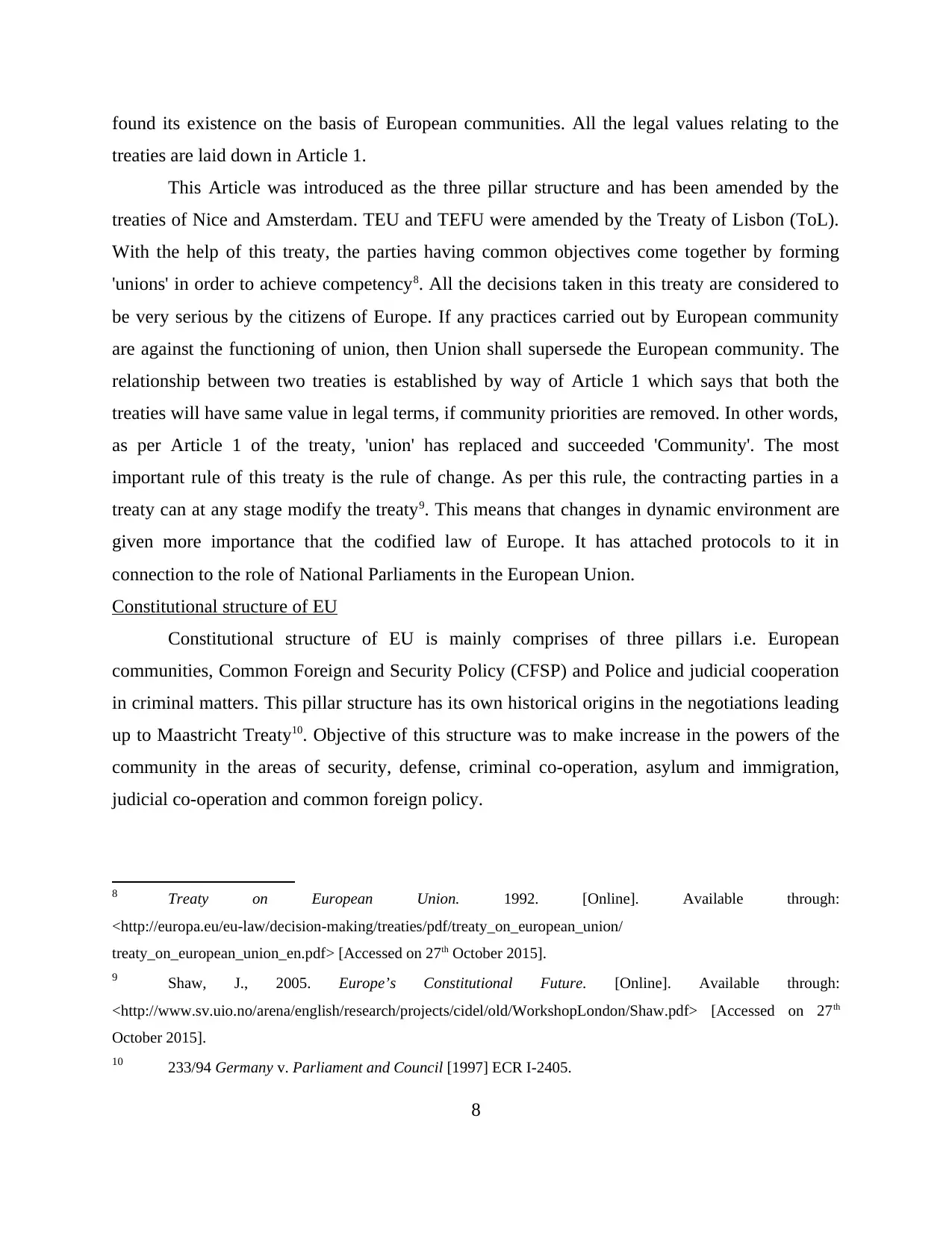
found its existence on the basis of European communities. All the legal values relating to the
treaties are laid down in Article 1.
This Article was introduced as the three pillar structure and has been amended by the
treaties of Nice and Amsterdam. TEU and TEFU were amended by the Treaty of Lisbon (ToL).
With the help of this treaty, the parties having common objectives come together by forming
'unions' in order to achieve competency8. All the decisions taken in this treaty are considered to
be very serious by the citizens of Europe. If any practices carried out by European community
are against the functioning of union, then Union shall supersede the European community. The
relationship between two treaties is established by way of Article 1 which says that both the
treaties will have same value in legal terms, if community priorities are removed. In other words,
as per Article 1 of the treaty, 'union' has replaced and succeeded 'Community'. The most
important rule of this treaty is the rule of change. As per this rule, the contracting parties in a
treaty can at any stage modify the treaty9. This means that changes in dynamic environment are
given more importance that the codified law of Europe. It has attached protocols to it in
connection to the role of National Parliaments in the European Union.
Constitutional structure of EU
Constitutional structure of EU is mainly comprises of three pillars i.e. European
communities, Common Foreign and Security Policy (CFSP) and Police and judicial cooperation
in criminal matters. This pillar structure has its own historical origins in the negotiations leading
up to Maastricht Treaty10. Objective of this structure was to make increase in the powers of the
community in the areas of security, defense, criminal co-operation, asylum and immigration,
judicial co-operation and common foreign policy.
8 Treaty on European Union. 1992. [Online]. Available through:
<http://europa.eu/eu-law/decision-making/treaties/pdf/treaty_on_european_union/
treaty_on_european_union_en.pdf> [Accessed on 27th October 2015].
9 Shaw, J., 2005. Europe’s Constitutional Future. [Online]. Available through:
<http://www.sv.uio.no/arena/english/research/projects/cidel/old/WorkshopLondon/Shaw.pdf> [Accessed on 27th
October 2015].
10 233/94 Germany v. Parliament and Council [1997] ECR I-2405.
8
treaties are laid down in Article 1.
This Article was introduced as the three pillar structure and has been amended by the
treaties of Nice and Amsterdam. TEU and TEFU were amended by the Treaty of Lisbon (ToL).
With the help of this treaty, the parties having common objectives come together by forming
'unions' in order to achieve competency8. All the decisions taken in this treaty are considered to
be very serious by the citizens of Europe. If any practices carried out by European community
are against the functioning of union, then Union shall supersede the European community. The
relationship between two treaties is established by way of Article 1 which says that both the
treaties will have same value in legal terms, if community priorities are removed. In other words,
as per Article 1 of the treaty, 'union' has replaced and succeeded 'Community'. The most
important rule of this treaty is the rule of change. As per this rule, the contracting parties in a
treaty can at any stage modify the treaty9. This means that changes in dynamic environment are
given more importance that the codified law of Europe. It has attached protocols to it in
connection to the role of National Parliaments in the European Union.
Constitutional structure of EU
Constitutional structure of EU is mainly comprises of three pillars i.e. European
communities, Common Foreign and Security Policy (CFSP) and Police and judicial cooperation
in criminal matters. This pillar structure has its own historical origins in the negotiations leading
up to Maastricht Treaty10. Objective of this structure was to make increase in the powers of the
community in the areas of security, defense, criminal co-operation, asylum and immigration,
judicial co-operation and common foreign policy.
8 Treaty on European Union. 1992. [Online]. Available through:
<http://europa.eu/eu-law/decision-making/treaties/pdf/treaty_on_european_union/
treaty_on_european_union_en.pdf> [Accessed on 27th October 2015].
9 Shaw, J., 2005. Europe’s Constitutional Future. [Online]. Available through:
<http://www.sv.uio.no/arena/english/research/projects/cidel/old/WorkshopLondon/Shaw.pdf> [Accessed on 27th
October 2015].
10 233/94 Germany v. Parliament and Council [1997] ECR I-2405.
8
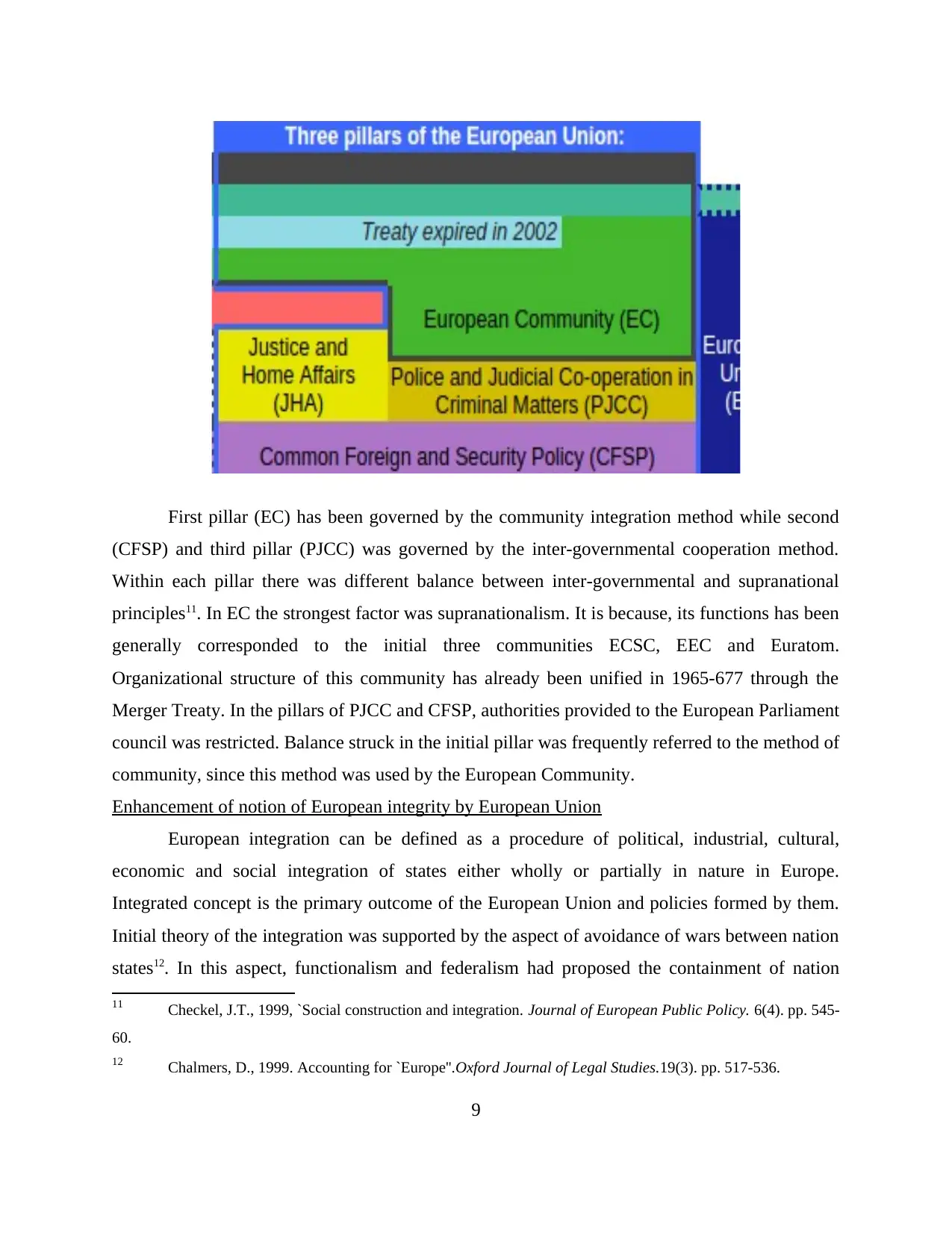
First pillar (EC) has been governed by the community integration method while second
(CFSP) and third pillar (PJCC) was governed by the inter-governmental cooperation method.
Within each pillar there was different balance between inter-governmental and supranational
principles11. In EC the strongest factor was supranationalism. It is because, its functions has been
generally corresponded to the initial three communities ECSC, EEC and Euratom.
Organizational structure of this community has already been unified in 1965-677 through the
Merger Treaty. In the pillars of PJCC and CFSP, authorities provided to the European Parliament
council was restricted. Balance struck in the initial pillar was frequently referred to the method of
community, since this method was used by the European Community.
Enhancement of notion of European integrity by European Union
European integration can be defined as a procedure of political, industrial, cultural,
economic and social integration of states either wholly or partially in nature in Europe.
Integrated concept is the primary outcome of the European Union and policies formed by them.
Initial theory of the integration was supported by the aspect of avoidance of wars between nation
states12. In this aspect, functionalism and federalism had proposed the containment of nation
11 Checkel, J.T., 1999, `Social construction and integration. Journal of European Public Policy. 6(4). pp. 545-
60.
12 Chalmers, D., 1999. Accounting for `Europe''.Oxford Journal of Legal Studies.19(3). pp. 517-536.
9
(CFSP) and third pillar (PJCC) was governed by the inter-governmental cooperation method.
Within each pillar there was different balance between inter-governmental and supranational
principles11. In EC the strongest factor was supranationalism. It is because, its functions has been
generally corresponded to the initial three communities ECSC, EEC and Euratom.
Organizational structure of this community has already been unified in 1965-677 through the
Merger Treaty. In the pillars of PJCC and CFSP, authorities provided to the European Parliament
council was restricted. Balance struck in the initial pillar was frequently referred to the method of
community, since this method was used by the European Community.
Enhancement of notion of European integrity by European Union
European integration can be defined as a procedure of political, industrial, cultural,
economic and social integration of states either wholly or partially in nature in Europe.
Integrated concept is the primary outcome of the European Union and policies formed by them.
Initial theory of the integration was supported by the aspect of avoidance of wars between nation
states12. In this aspect, functionalism and federalism had proposed the containment of nation
11 Checkel, J.T., 1999, `Social construction and integration. Journal of European Public Policy. 6(4). pp. 545-
60.
12 Chalmers, D., 1999. Accounting for `Europe''.Oxford Journal of Legal Studies.19(3). pp. 517-536.
9
⊘ This is a preview!⊘
Do you want full access?
Subscribe today to unlock all pages.

Trusted by 1+ million students worldwide
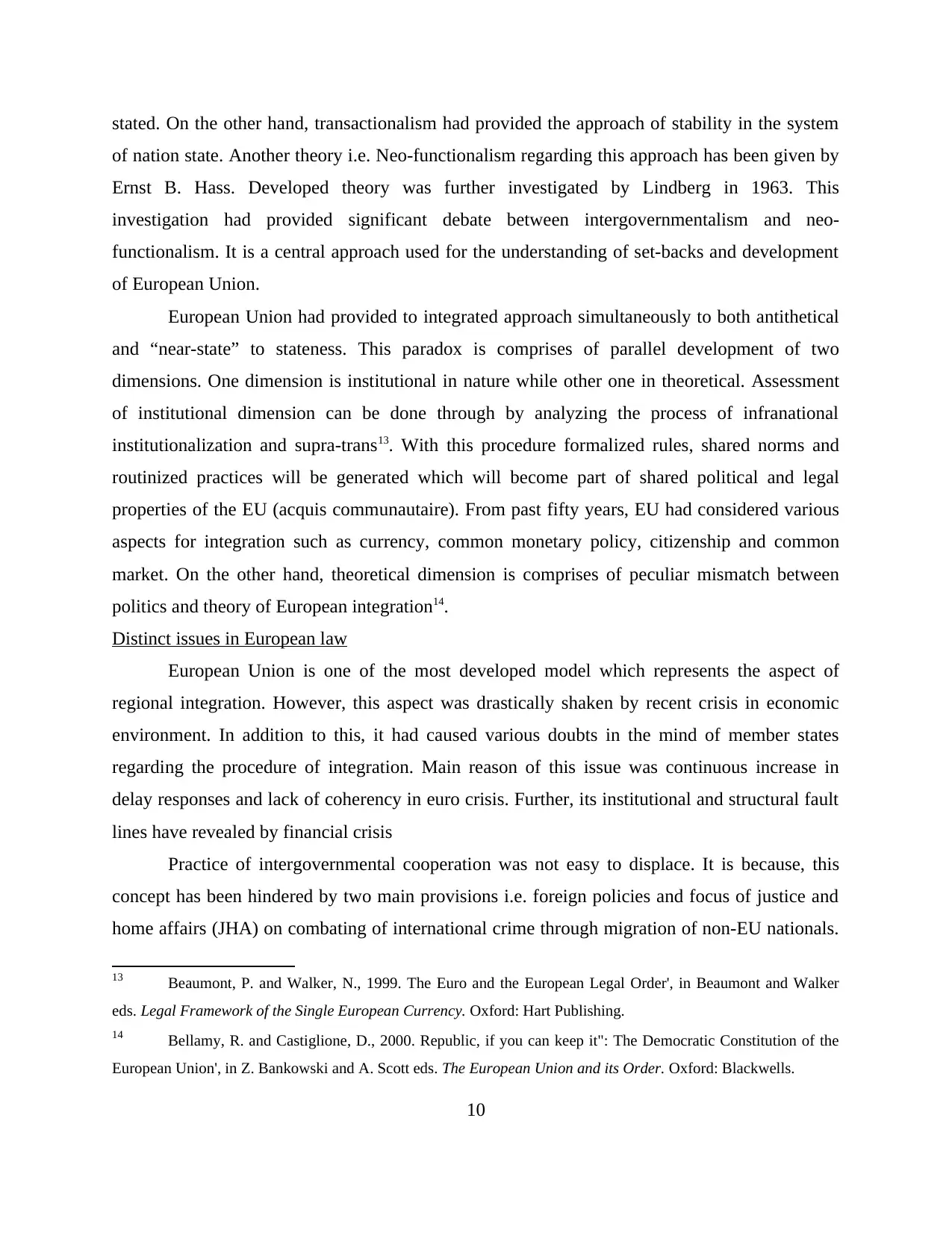
stated. On the other hand, transactionalism had provided the approach of stability in the system
of nation state. Another theory i.e. Neo-functionalism regarding this approach has been given by
Ernst B. Hass. Developed theory was further investigated by Lindberg in 1963. This
investigation had provided significant debate between intergovernmentalism and neo-
functionalism. It is a central approach used for the understanding of set-backs and development
of European Union.
European Union had provided to integrated approach simultaneously to both antithetical
and “near-state” to stateness. This paradox is comprises of parallel development of two
dimensions. One dimension is institutional in nature while other one in theoretical. Assessment
of institutional dimension can be done through by analyzing the process of infranational
institutionalization and supra-trans13. With this procedure formalized rules, shared norms and
routinized practices will be generated which will become part of shared political and legal
properties of the EU (acquis communautaire). From past fifty years, EU had considered various
aspects for integration such as currency, common monetary policy, citizenship and common
market. On the other hand, theoretical dimension is comprises of peculiar mismatch between
politics and theory of European integration14.
Distinct issues in European law
European Union is one of the most developed model which represents the aspect of
regional integration. However, this aspect was drastically shaken by recent crisis in economic
environment. In addition to this, it had caused various doubts in the mind of member states
regarding the procedure of integration. Main reason of this issue was continuous increase in
delay responses and lack of coherency in euro crisis. Further, its institutional and structural fault
lines have revealed by financial crisis
Practice of intergovernmental cooperation was not easy to displace. It is because, this
concept has been hindered by two main provisions i.e. foreign policies and focus of justice and
home affairs (JHA) on combating of international crime through migration of non-EU nationals.
13 Beaumont, P. and Walker, N., 1999. The Euro and the European Legal Order', in Beaumont and Walker
eds. Legal Framework of the Single European Currency. Oxford: Hart Publishing.
14 Bellamy, R. and Castiglione, D., 2000. Republic, if you can keep it": The Democratic Constitution of the
European Union', in Z. Bankowski and A. Scott eds. The European Union and its Order. Oxford: Blackwells.
10
of nation state. Another theory i.e. Neo-functionalism regarding this approach has been given by
Ernst B. Hass. Developed theory was further investigated by Lindberg in 1963. This
investigation had provided significant debate between intergovernmentalism and neo-
functionalism. It is a central approach used for the understanding of set-backs and development
of European Union.
European Union had provided to integrated approach simultaneously to both antithetical
and “near-state” to stateness. This paradox is comprises of parallel development of two
dimensions. One dimension is institutional in nature while other one in theoretical. Assessment
of institutional dimension can be done through by analyzing the process of infranational
institutionalization and supra-trans13. With this procedure formalized rules, shared norms and
routinized practices will be generated which will become part of shared political and legal
properties of the EU (acquis communautaire). From past fifty years, EU had considered various
aspects for integration such as currency, common monetary policy, citizenship and common
market. On the other hand, theoretical dimension is comprises of peculiar mismatch between
politics and theory of European integration14.
Distinct issues in European law
European Union is one of the most developed model which represents the aspect of
regional integration. However, this aspect was drastically shaken by recent crisis in economic
environment. In addition to this, it had caused various doubts in the mind of member states
regarding the procedure of integration. Main reason of this issue was continuous increase in
delay responses and lack of coherency in euro crisis. Further, its institutional and structural fault
lines have revealed by financial crisis
Practice of intergovernmental cooperation was not easy to displace. It is because, this
concept has been hindered by two main provisions i.e. foreign policies and focus of justice and
home affairs (JHA) on combating of international crime through migration of non-EU nationals.
13 Beaumont, P. and Walker, N., 1999. The Euro and the European Legal Order', in Beaumont and Walker
eds. Legal Framework of the Single European Currency. Oxford: Hart Publishing.
14 Bellamy, R. and Castiglione, D., 2000. Republic, if you can keep it": The Democratic Constitution of the
European Union', in Z. Bankowski and A. Scott eds. The European Union and its Order. Oxford: Blackwells.
10
Paraphrase This Document
Need a fresh take? Get an instant paraphrase of this document with our AI Paraphraser
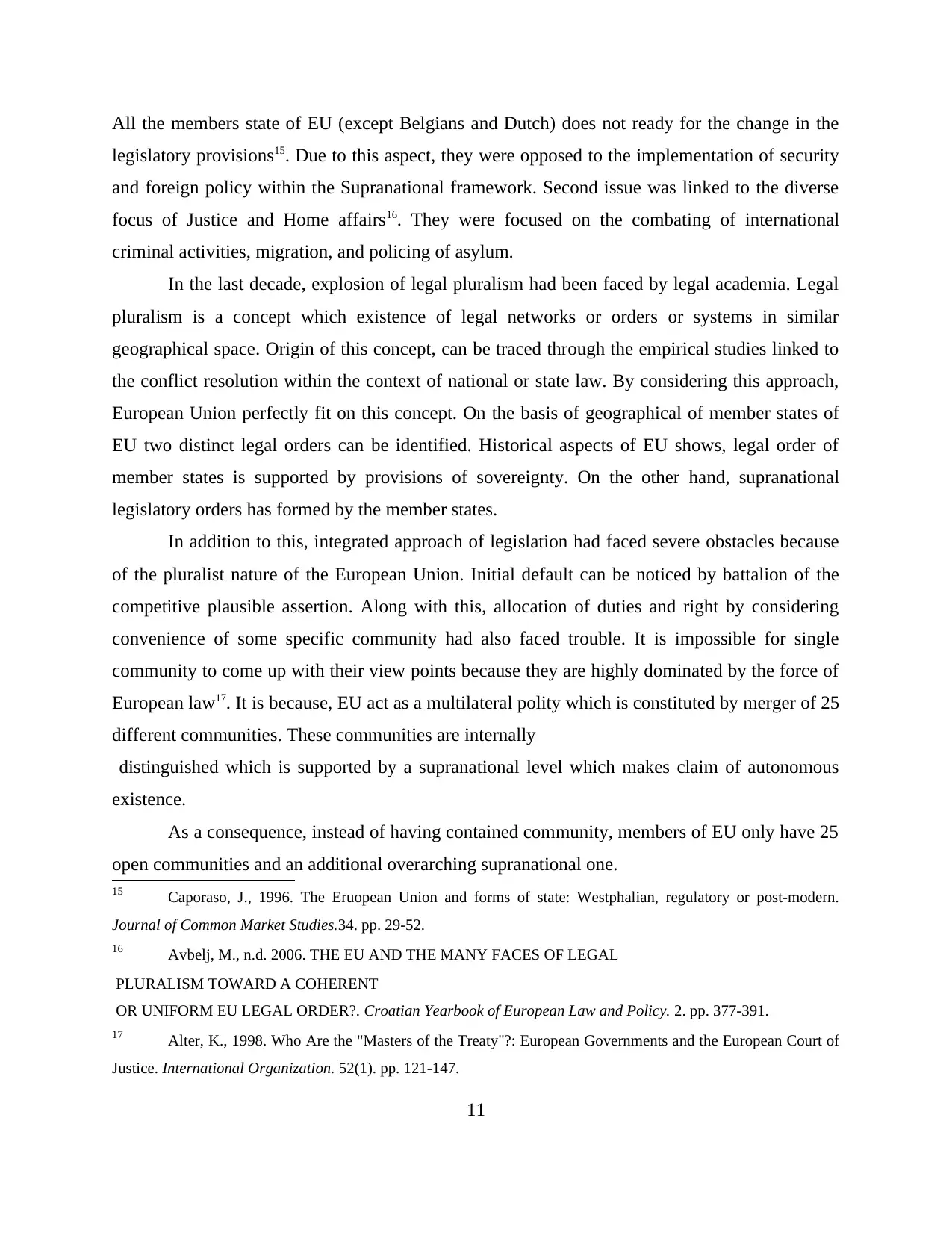
All the members state of EU (except Belgians and Dutch) does not ready for the change in the
legislatory provisions15. Due to this aspect, they were opposed to the implementation of security
and foreign policy within the Supranational framework. Second issue was linked to the diverse
focus of Justice and Home affairs16. They were focused on the combating of international
criminal activities, migration, and policing of asylum.
In the last decade, explosion of legal pluralism had been faced by legal academia. Legal
pluralism is a concept which existence of legal networks or orders or systems in similar
geographical space. Origin of this concept, can be traced through the empirical studies linked to
the conflict resolution within the context of national or state law. By considering this approach,
European Union perfectly fit on this concept. On the basis of geographical of member states of
EU two distinct legal orders can be identified. Historical aspects of EU shows, legal order of
member states is supported by provisions of sovereignty. On the other hand, supranational
legislatory orders has formed by the member states.
In addition to this, integrated approach of legislation had faced severe obstacles because
of the pluralist nature of the European Union. Initial default can be noticed by battalion of the
competitive plausible assertion. Along with this, allocation of duties and right by considering
convenience of some specific community had also faced trouble. It is impossible for single
community to come up with their view points because they are highly dominated by the force of
European law17. It is because, EU act as a multilateral polity which is constituted by merger of 25
different communities. These communities are internally
distinguished which is supported by a supranational level which makes claim of autonomous
existence.
As a consequence, instead of having contained community, members of EU only have 25
open communities and an additional overarching supranational one.
15 Caporaso, J., 1996. The Eruopean Union and forms of state: Westphalian, regulatory or post-modern.
Journal of Common Market Studies.34. pp. 29-52.
16 Avbelj, M., n.d. 2006. THE EU AND THE MANY FACES OF LEGAL
PLURALISM TOWARD A COHERENT
OR UNIFORM EU LEGAL ORDER?. Croatian Yearbook of European Law and Policy. 2. pp. 377-391.
17 Alter, K., 1998. Who Are the "Masters of the Treaty"?: European Governments and the European Court of
Justice. International Organization. 52(1). pp. 121-147.
11
legislatory provisions15. Due to this aspect, they were opposed to the implementation of security
and foreign policy within the Supranational framework. Second issue was linked to the diverse
focus of Justice and Home affairs16. They were focused on the combating of international
criminal activities, migration, and policing of asylum.
In the last decade, explosion of legal pluralism had been faced by legal academia. Legal
pluralism is a concept which existence of legal networks or orders or systems in similar
geographical space. Origin of this concept, can be traced through the empirical studies linked to
the conflict resolution within the context of national or state law. By considering this approach,
European Union perfectly fit on this concept. On the basis of geographical of member states of
EU two distinct legal orders can be identified. Historical aspects of EU shows, legal order of
member states is supported by provisions of sovereignty. On the other hand, supranational
legislatory orders has formed by the member states.
In addition to this, integrated approach of legislation had faced severe obstacles because
of the pluralist nature of the European Union. Initial default can be noticed by battalion of the
competitive plausible assertion. Along with this, allocation of duties and right by considering
convenience of some specific community had also faced trouble. It is impossible for single
community to come up with their view points because they are highly dominated by the force of
European law17. It is because, EU act as a multilateral polity which is constituted by merger of 25
different communities. These communities are internally
distinguished which is supported by a supranational level which makes claim of autonomous
existence.
As a consequence, instead of having contained community, members of EU only have 25
open communities and an additional overarching supranational one.
15 Caporaso, J., 1996. The Eruopean Union and forms of state: Westphalian, regulatory or post-modern.
Journal of Common Market Studies.34. pp. 29-52.
16 Avbelj, M., n.d. 2006. THE EU AND THE MANY FACES OF LEGAL
PLURALISM TOWARD A COHERENT
OR UNIFORM EU LEGAL ORDER?. Croatian Yearbook of European Law and Policy. 2. pp. 377-391.
17 Alter, K., 1998. Who Are the "Masters of the Treaty"?: European Governments and the European Court of
Justice. International Organization. 52(1). pp. 121-147.
11
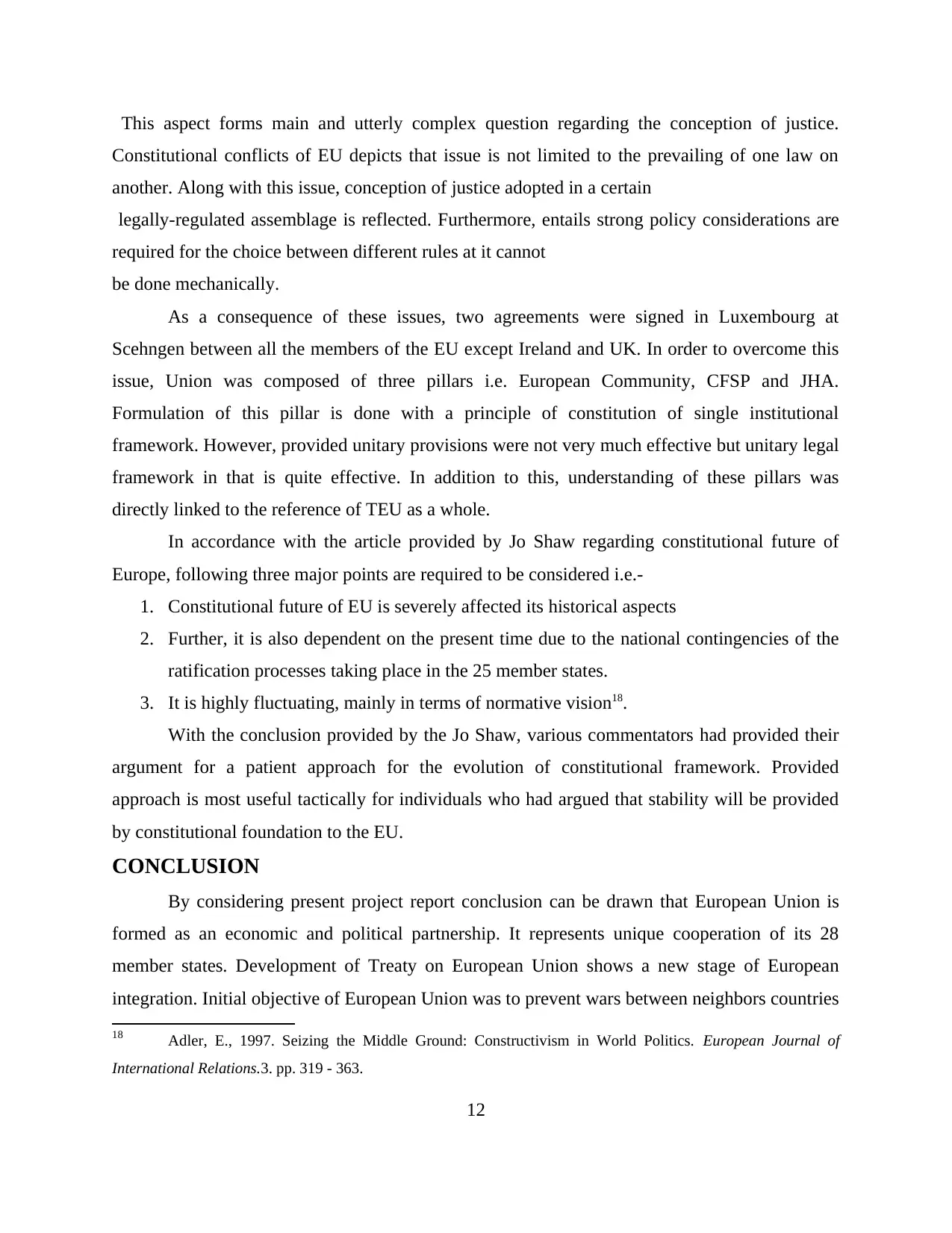
This aspect forms main and utterly complex question regarding the conception of justice.
Constitutional conflicts of EU depicts that issue is not limited to the prevailing of one law on
another. Along with this issue, conception of justice adopted in a certain
legally-regulated assemblage is reflected. Furthermore, entails strong policy considerations are
required for the choice between different rules at it cannot
be done mechanically.
As a consequence of these issues, two agreements were signed in Luxembourg at
Scehngen between all the members of the EU except Ireland and UK. In order to overcome this
issue, Union was composed of three pillars i.e. European Community, CFSP and JHA.
Formulation of this pillar is done with a principle of constitution of single institutional
framework. However, provided unitary provisions were not very much effective but unitary legal
framework in that is quite effective. In addition to this, understanding of these pillars was
directly linked to the reference of TEU as a whole.
In accordance with the article provided by Jo Shaw regarding constitutional future of
Europe, following three major points are required to be considered i.e.-
1. Constitutional future of EU is severely affected its historical aspects
2. Further, it is also dependent on the present time due to the national contingencies of the
ratification processes taking place in the 25 member states.
3. It is highly fluctuating, mainly in terms of normative vision18.
With the conclusion provided by the Jo Shaw, various commentators had provided their
argument for a patient approach for the evolution of constitutional framework. Provided
approach is most useful tactically for individuals who had argued that stability will be provided
by constitutional foundation to the EU.
CONCLUSION
By considering present project report conclusion can be drawn that European Union is
formed as an economic and political partnership. It represents unique cooperation of its 28
member states. Development of Treaty on European Union shows a new stage of European
integration. Initial objective of European Union was to prevent wars between neighbors countries
18 Adler, E., 1997. Seizing the Middle Ground: Constructivism in World Politics. European Journal of
International Relations.3. pp. 319 - 363.
12
Constitutional conflicts of EU depicts that issue is not limited to the prevailing of one law on
another. Along with this issue, conception of justice adopted in a certain
legally-regulated assemblage is reflected. Furthermore, entails strong policy considerations are
required for the choice between different rules at it cannot
be done mechanically.
As a consequence of these issues, two agreements were signed in Luxembourg at
Scehngen between all the members of the EU except Ireland and UK. In order to overcome this
issue, Union was composed of three pillars i.e. European Community, CFSP and JHA.
Formulation of this pillar is done with a principle of constitution of single institutional
framework. However, provided unitary provisions were not very much effective but unitary legal
framework in that is quite effective. In addition to this, understanding of these pillars was
directly linked to the reference of TEU as a whole.
In accordance with the article provided by Jo Shaw regarding constitutional future of
Europe, following three major points are required to be considered i.e.-
1. Constitutional future of EU is severely affected its historical aspects
2. Further, it is also dependent on the present time due to the national contingencies of the
ratification processes taking place in the 25 member states.
3. It is highly fluctuating, mainly in terms of normative vision18.
With the conclusion provided by the Jo Shaw, various commentators had provided their
argument for a patient approach for the evolution of constitutional framework. Provided
approach is most useful tactically for individuals who had argued that stability will be provided
by constitutional foundation to the EU.
CONCLUSION
By considering present project report conclusion can be drawn that European Union is
formed as an economic and political partnership. It represents unique cooperation of its 28
member states. Development of Treaty on European Union shows a new stage of European
integration. Initial objective of European Union was to prevent wars between neighbors countries
18 Adler, E., 1997. Seizing the Middle Ground: Constructivism in World Politics. European Journal of
International Relations.3. pp. 319 - 363.
12
⊘ This is a preview!⊘
Do you want full access?
Subscribe today to unlock all pages.

Trusted by 1+ million students worldwide
1 out of 13
Related Documents
Your All-in-One AI-Powered Toolkit for Academic Success.
+13062052269
info@desklib.com
Available 24*7 on WhatsApp / Email
![[object Object]](/_next/static/media/star-bottom.7253800d.svg)
Unlock your academic potential
Copyright © 2020–2025 A2Z Services. All Rights Reserved. Developed and managed by ZUCOL.





